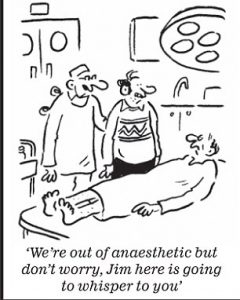I try to see each patient before they come back for surgery. It is not easy in the kind of fast-paced medical practice of today.
Each time I walk to a patient, the reception is different.
Some patients are friendly, others indifferent and resigned.
Every now and then, some think I am an orderly coming to roll them back for surgery. Can you blame them? – after all I’m black and speak with a funny accent.
Then is the occasional “Have you even finished Medical School yet?” Well, I cannot help my boyish, good looks. Hey, don’t hate!
Then are the really difficult patients who come in with their own treatment plan and expect every doctor and nurse to follow this treatment plan they pulled off the internet.
“I don’t want the IV till I am asleep!”
“I am leaving my dentures in!”
Then are those who won’t stop talking. God help you if you are pressed for time and you get a garrulous one.
“So, have you had any problems during an anesthetic?”
“Doc, You wouldn’t believe what happened in 1963, just after I came back from the war. Have you heard of Vietnam. Kate, how old was Emily then?”
My favorite ones are those with a sense of humor, the older patients with very interesting lives and the old ladies who think I’m cute as a button. Again – don’t hate!
I love to ask the older couples how long they’ve been married. Some of the answers are impressive. The record so far is 69 years. Is amazing how these old couples dote on each. So so heart warming.

Then are the frankly scared-out-of their-minds patients. The interesting bit is how each of them expresses their fear – flat affect, weepy, hostile, demanding, talkative, direct, unfriendly. Whatever the form of expression of this fear, you cannot but see it in their eyes. It has that get-me-out of-here look. it is really easy to chalk it to the patient being a horrible person. In my case, I could always pull out the race card. However, I think it’s in those instances that one should stop being a doctor and be a fellow human being. It is in those moments that one should lose the impersonal tone and warm up to the patient. Break the ice.
I am rather direct and go “You look worried. What is bothering you?” or “You look totally scared. Want to ran away?” The reactions are interesting. I always get a torrent – of tears or words. The men are tougher to crack. You know us. We need to be tough and all.
Once the torrent starts, I just listen or wait with a box of tissues ready till they finish crying and then listen.
Listen to their fears. Listen. As you do, don’t be disdainful, even if their fears sound silly to you. Call up all the empathy you have. When they are done, try to explain in lay terms why each fear is realistic or not and if realistic, what the surgical and anesthesia teams do to prevent any such misfortune(s) from happening. The little expression of humanity is way better than any anxiolytic you can order for the patient, believe me.
A surgical procedure is very scary for most patients. It is a time in one’s life where one is totally at the mercy of other people (air travel offers s similar situation). These am-at-their-mercy people are supposed to be experts but how good are they really? Are they rested enough? How many of these procedures have they done? A patient is supposed to have asked all these questions at the surgeon’s office but for some, their fears were not allayed enough. There is that element of chance. What if something goes wrong?
Then there are those facing terminal illness or the possibility of a terminal diagnosis.
Is it a surprise that some patients are scared out of their wits?
We are doctors, highly trained in the art of healing. That is our job. We are pressed for time. We have to leave emotion out of it. Beyond all that we are also humans. So are the patients. Sometimes, these patients want to see that human. Show it to them.
